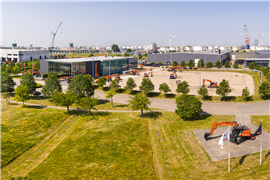Excavators – designed for demolition
01 March 2021
There is always an air of excitement when a new excavator specifically designed for demolition applications is introduced to the market.
Witness the Caterpillar 352 UHD machine. A year ago it was being demonstrated for the first time at the US National Demolition Association Live Demo event in Austin, Texas. Last November it earned the recognition of the World Demolition Awards international judging panel in winning the event’s Manufacturer Innovation Plant and Equipment category. At the start of 2021, the company gave the product its official launch, alongside the smaller but still demolition-specific 340 UHD.
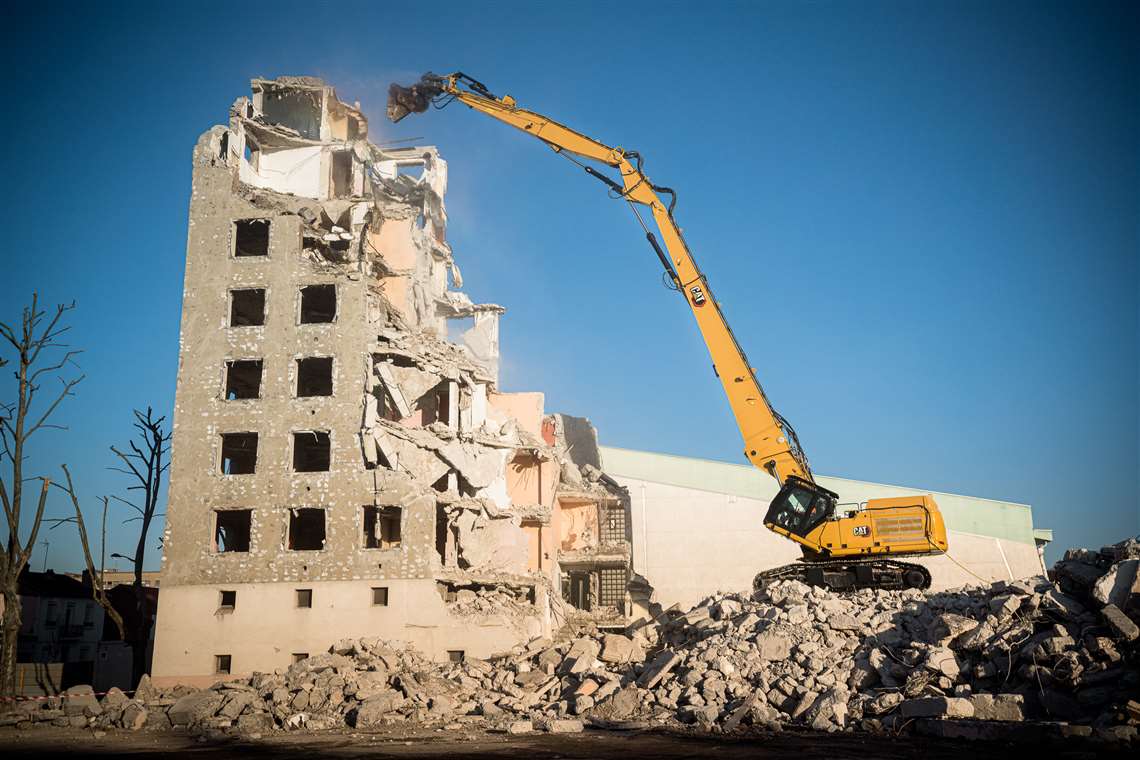 Caterpillar’s 352 UHD demolition excavator, a World Demolition Awards winner
Caterpillar’s 352 UHD demolition excavator, a World Demolition Awards winner
According to Caterpillar, the excavator has been designed to handle difficult demolition of tall structures using a range of the company’s demolition attachments, including multi-processors, grapples, shears and hydraulic hammers with the retrofit boom.
Switching between boom positions
The UHD front can be switched for a straight or bent (retrofit) boom position for lower-level demolition and earthmoving applications. According to Cat, this typically takes about 15 minutes with two people with no special tool required. The 352 UHD features a variable-gauge undercarriage (hydraulically activated), as well as the Cat Active Stability Monitoring system, which continuously informs the operator of work tool position within a safe working range and warns when approaching stability limits.
In the UHD configuration, the 352 UHD provides 28 m (91 ft) of vertical height to the work tool attachment pin, and 15.8 m (51 ft) of horizontal reach, when working with a 3.7 t (8,500 lb) tool.
“I’m not sure I can put into words how excited I was to hear that we had won the World Demolition Award,” said Brian Abbott, Caterpillar’s worldwide product manager for large excavators.
“I was humbled to be recognised by the experts who made that decision.
“The 352 UHD has a lot of specific demolition added features, and a lot of work has gone into the basics.
“We have changed the undercarriage to improve stability. Visibility is a big thing that we have worked on. There is a lot of glass compared to other cabs, and the option of a 360° bird’s eye camera.”
The Cat demolition cab features a falling objects guard structure (FOGS) and includes front and roof laminated glass with a P5A impact rating.
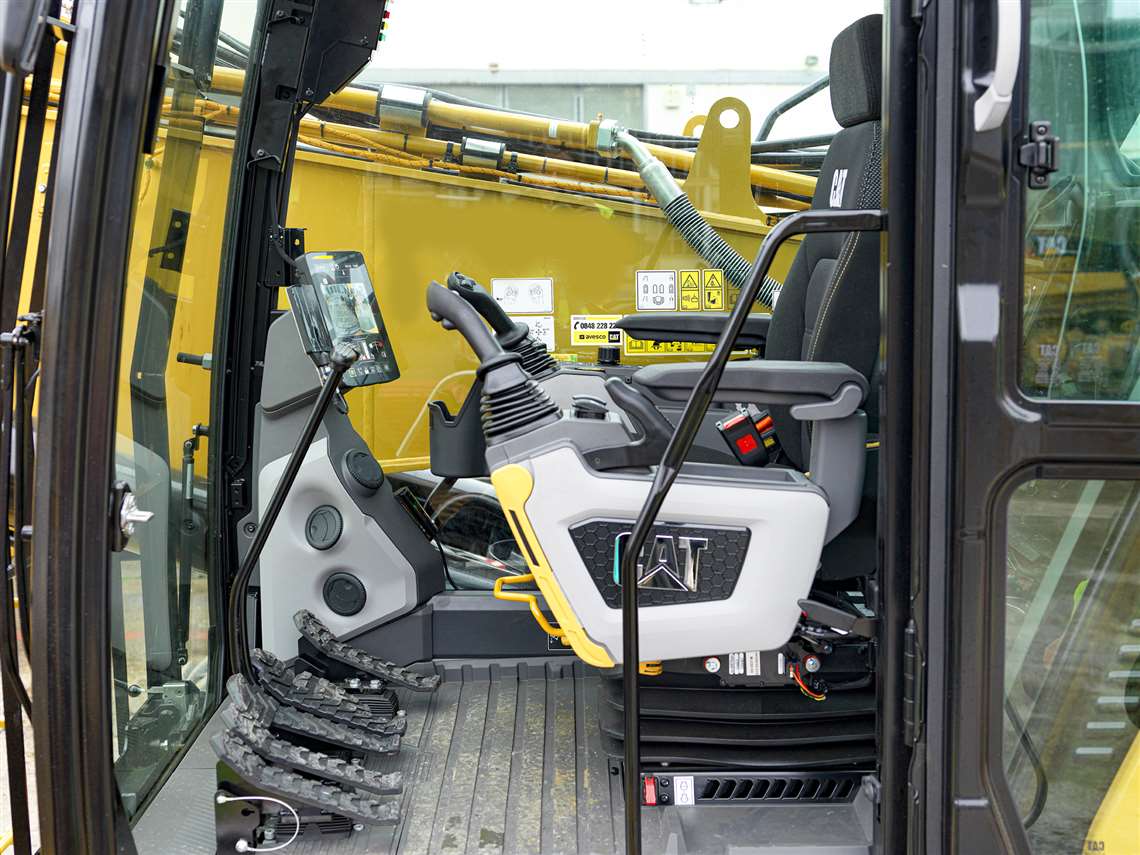 Inside the cab of the Cat 340 UHD demolition excavator
Inside the cab of the Cat 340 UHD demolition excavator
The cabs tilt up 30 degrees for an optimum line of sight to the work tool and for a more productive, more comfortable working position for the operator. The windscreen and roof glass feature one-piece, parallel wipers with three intermittent settings with washer spray.
Also new from Cat is the 340 UHD ultra high demolition excavator, launched in January for the European, Turkish and Israeli markets. Capable of working on eight storey high structures, the 58 t model is fitted with a Stage V Cat C9.3B engine and has a 13% higher pin height than the 340F UHD predecessor model.
Cat said the UHD and Retrofit boom/stick configurations help to “deliver increased machine flexibility to meet contractors’ job site needs to maximise machine utilisation”. The 340 UHD has a unique coupling system that lets users switch between two UHD fronts, Retrofit booms and sticks with no special tools in 15 minutes.
According to Cat, contractors can choose either a one or two-piece boom option for truck loading or low level demolition work. The redesigned cradle of the one-piece boom is said to give the machine a transport height of less than 3 m (10 ft).
The 340 UHD’s hydraulic undercarriage can be extended to 4 (13 ft) m wide for improved stability and retracted to just 3 m for easier transport.
Inside the cab, Cat has provided operators with a larger premium heated – and cooled – seat, and a 254 mm (10 in) high-resolution touchscreen monitor. Through the new monitor operators can view the manufacturer’s active stability monitoring system, which gives audible and visual alerts when the work tool position is approaching its stability limit.
The touchscreen also includes technology such as Cat Payload, Cat E-Fence and Cat Grade with 2D, which automatically guides depth, slope and horizontal distance to maximise machine productivity.
Selective deconstruction with the Liebherr R 940 Demolition
The Liebherr France development and production site launched a demolition excavator for the global market in September last year.
The R 940 Demolition is the successor to the R 944 C and joins a product range that already includes the R 950 Demolition and the R 960 Demolition.
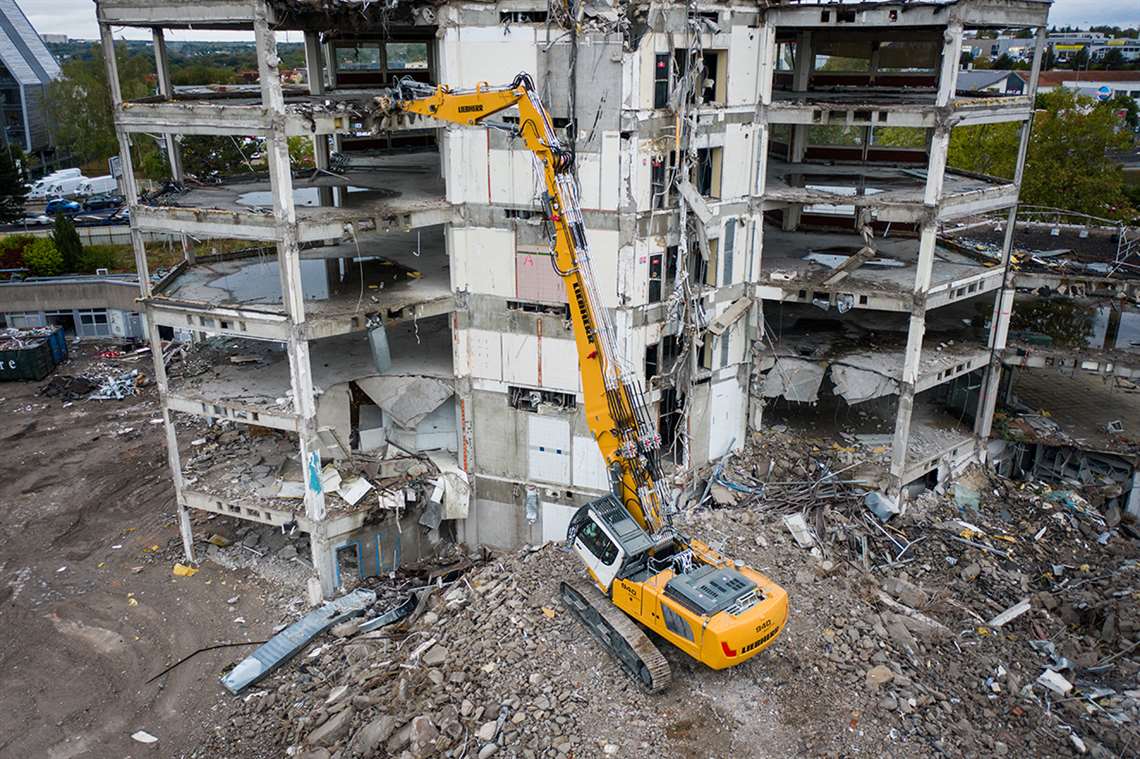 The Liebherr R940 demolition excavator
The Liebherr R940 demolition excavator
Liebherr, whose French operation is based in Colmar in the east of the country, has more than 50 years’ experience developing and producing demolition excavators. Like other products in the range, the R 940 Demolition features optimal properties for selective deconstruction. The company says that apart from the Liebherr Demolition Control System (LDC) – which shows the driver the position of the demolition tool to guarantee the stability of the excavator – a 30° tiltable cab ensures an optimal view of the working area. The hydraulically adjustable undercarriage with variable track gauge facilitates transport and the counterweight can be removed. The Liebherr engine, which complies with exhaust emissions standard Stage V, reaches an output of 200 kW, features a diesel oxidation catalyst, SCR system, particulate filter and does not have an EGR valve, which the company believes ensures lower fuel consumption and higher productivity. This machine is also available in a Tier 4 Final version, as well as for less regulated markets with a corresponding engine.
A cab air filtration system for a healthy work environment and a spray system for reducing dust in the working area are available as optional equipment for the R 940 Demolition. The machine can also be equipped with an air compressor for cleaning the radiator and cab.
The Liebherr Demolition Control System, which received the Intermat Innovation Award in 2018, shows the driver the position of the demolition tool, said to guarantee the stability of the excavator. The company said that in this way, it was possible to reduce to a minimum the probability of an operating error that could impair the stability of the machine. With the active safety components of the LDC, the driver has real time information in his field of vision on the tilt angle of the machine and the tool position. If a critical value is exceeded, the LDC automatically triggers electronic range information. The safety system informs the driver about every movement of the equipment which could impact the stability of the excavator.
Comfort and safety in the cab
Also launched in the second half of 2020, Hitachi’s next generation of Zaxis-7 large excavators comprises the ZX490LCH-7, ZX530LCH-7, ZX690LCH-7 and ZX890LCH-7 Stage-V compliant models.
Hitachi has also paid close attention to the cab, creating what it calls an industry leader in terms of comfort and safety.
The excavators feature fuel savings of up to 20% compared to previous models, while the machines can be controlled by using the new ECO gauge visible on the cab’s multifunctional 200 mm (8 in) monitor.
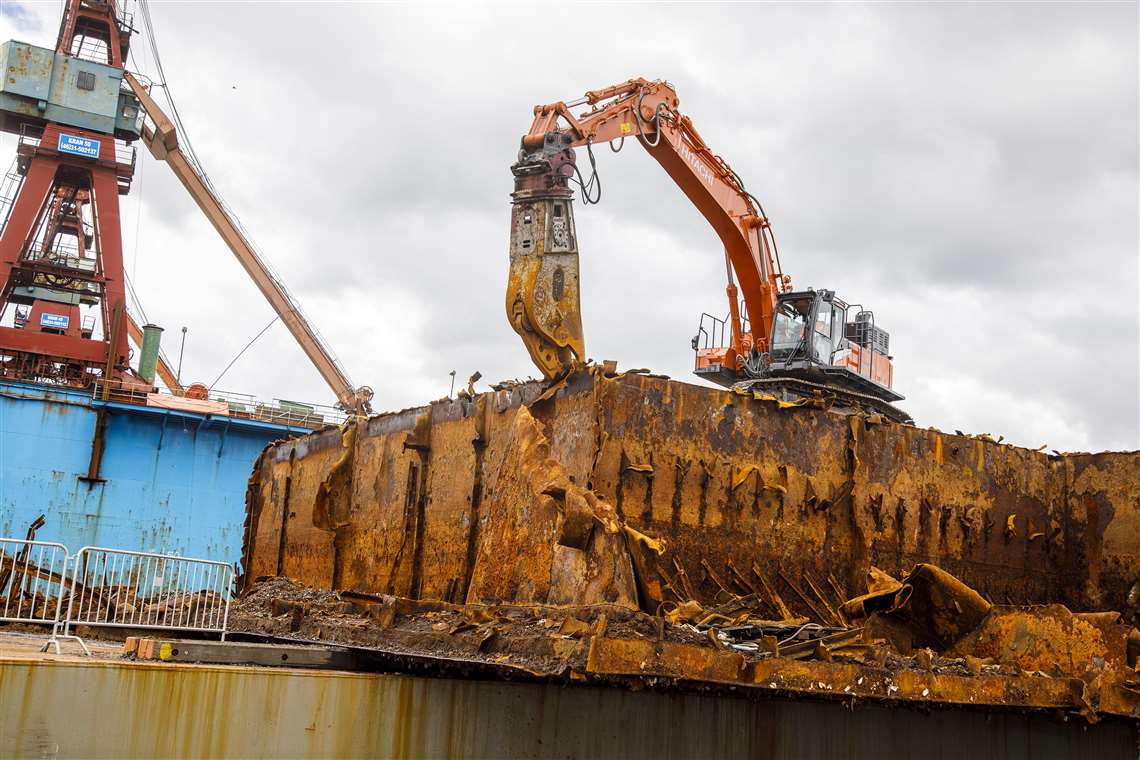 Hitachi said its Zaxis-7 demolition excavators give up to 20% fuel savings compared to previous models
Hitachi said its Zaxis-7 demolition excavators give up to 20% fuel savings compared to previous models
In terms of job site safety, operators have a 270° bird’s eye view from the Aerial Angle camera systems and users can choose from six image options to see the machine’s immediate environment. In addition, Hitachi remote monitoring systems Owner’s site and ConSite send operational data from the excavator to Global e-Service daily.
“We’re proud to present the latest range of Hitachi large excavators to our European customers,” said Hitachi Construction Machinery (Europe) president Makoto Yamazawa.
“Hitachi has continuously improved on previous generation machines to enhance the operator’s experience in the cab, to meet the needs of owners, and to provide support over the life cycle of our machines.
“By working in partnership with customers, we can help them to create their vision of a demolition excavator.”
A mobile demolition machine from Sennebogen’s 825 E-Series with quick-change system installed on the grab stick is described as combining the qualities of a material handler designed and thoroughly proven to withstand continuous use in scrap yards with the classic features of a robust and stable demolition excavator.
The company says the machine has the advantage of being moved more quickly and easily for smaller, inner-city demolition projects.
Making the best use of operator manpower
According to Sennebogen, the days when many different construction machines could be seen on demolition sites are now a thing of the past. Indeed, there is a clear trend towards optimised machine park planning to minimise downtimes, to make the best possible use of the operator’s manpower and to further restrict the narrow working area with unused machines.
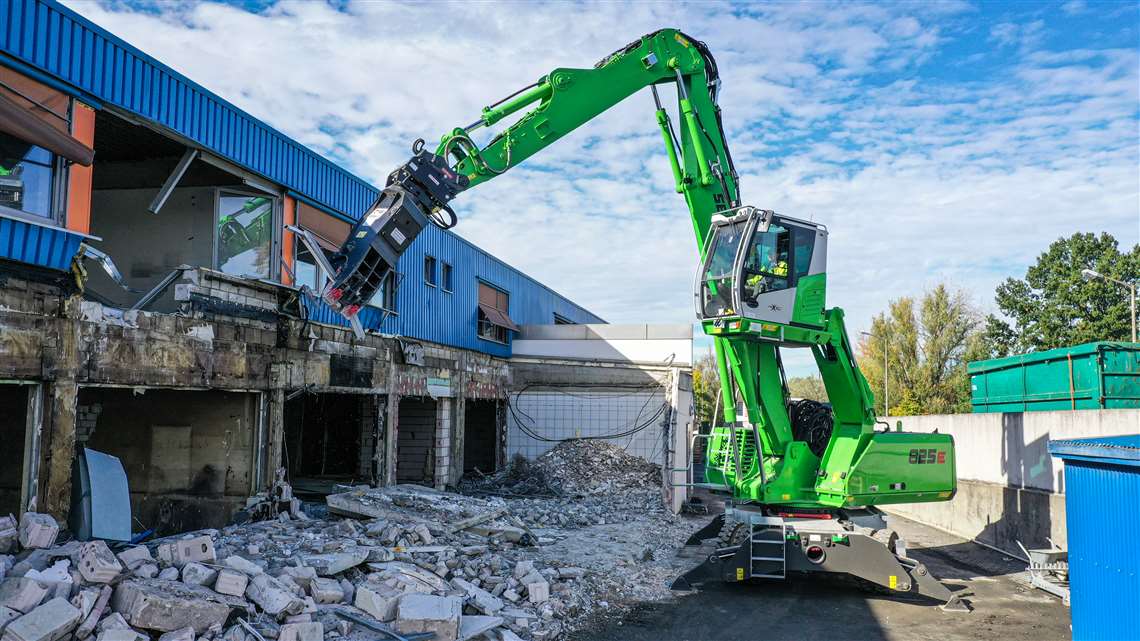 Sennebogen’s 825E seires offers excavators with either shears or demolition grab
Sennebogen’s 825E seires offers excavators with either shears or demolition grab
The company has developed special transport kinematics for the 825 E-Series demolition, where the machine is transported in its entirety without removing the stick or counterweight.
A range of “green efficiency” technologies mean that the company’s diesel-powered machines can operate with particularly low emissions, low wear and tear and save energy. Volvo Construction Equipment (CE) describes excavators as “one of the most effective pieces of equipment on a demolition site today” and continues to offer machines that are entirely built in-house. These comprise the EC380EHR, EC480EHR and EC750EHR, which range in weight from 51,000 to 103,028 kg (112,435 to 227,137 lb). The EC750EHR high reach model, the largest in the range, has pin reach capabilities from to 36 m (118 ft) above ground to 10 m (32 ft) below.
“When making the machine from bottom up for demolition, it is easy and cost effective for us to put the highest safety standards in the cabin and the complete guarding of the machine,” the company said.
“Dedicated demolition excavators have much larger boom cylinders, heavy frames and extra counterweight. They also have hydraulically extendable tracks, which give operators a 360° working range.”
- Article first published in the January-February 2021 issue of Demolition & Recycling International
CONNECT WITH THE TEAM









